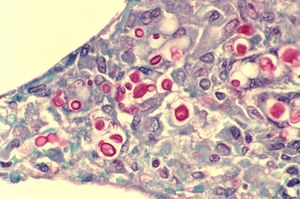Cryptococcosis
Introduction
Cryptococcosis is a life threatening fungal infection caused by members of the Cryptococcus genus. The two species known to cause cryptococcosis are C. neoformans and C. gattii. Cryptococcosis generally presents as one of three different infections, although all three infections can present in the same patient. Cutaneous cryptococcosis is an external infection, generally presenting as a rash or in an open wound. Pulmonary cryptococcosis is a lung infection, contracted by inhaling propagules formed by the adult fungi. Cryptococcal meningitis is an infection of the meninges in the brain, and is thought to result from the spread of the fungus in advanced cases of pulmonary cryptococcosis. Cryptococcosis is one of the most common AIDS-defining opportunistic infections in the world, and is rarely seen in non-immunocompromised persons [1]

Other examples:
Bold
Italic
Subscript: H2O
Superscript: Fe3+
Section 1 Genetics
Include some current research, with at least one image.

Sample citations: [2]
[3]
A citation code consists of a hyperlinked reference within "ref" begin and end codes.
Section 2 Microbiome
Include some current research, with a second image.
Conclusion
Overall text length should be at least 1,000 words (before counting references), with at least 2 images. Include at least 5 references under Reference section.
References
Edited by Eli Neal, student of Joan Slonczewski for BIOL 116 Information in Living Systems, 2019, Kenyon College.
